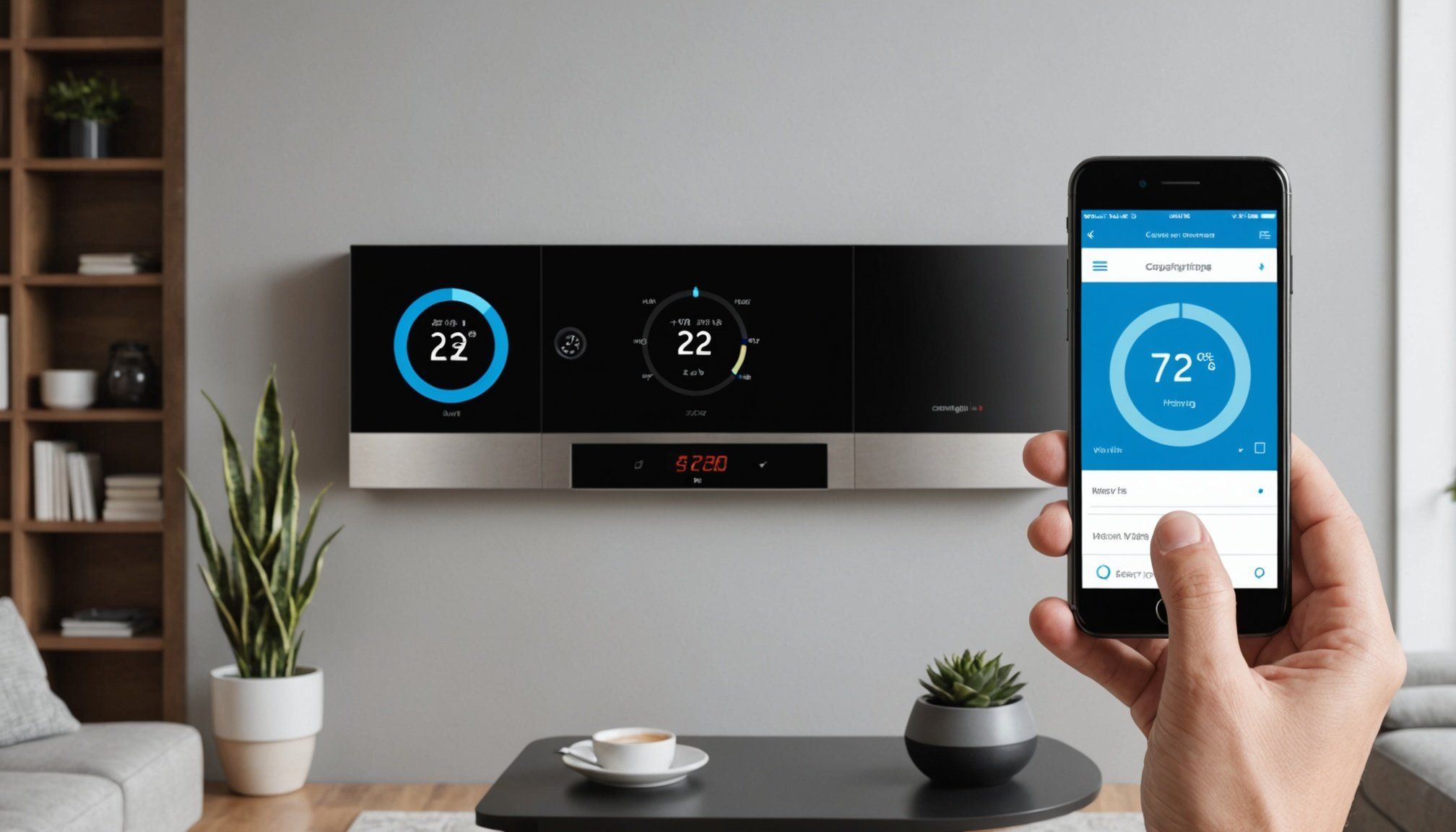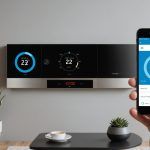Understanding Zone Temperature Control
Zone Temperature Control is a sophisticated approach to home heating, where different areas in a home maintain individual climate settings. It plays a crucial role in creating comfortable living environments while optimizing energy consumption. By employing such systems, homeowners can significantly lower their utility costs and reduce their carbon footprint.
Smartphone technology enhances heating efficiency within these systems by providing real-time data and remote management options. Through smart heating solutions, users can adjust temperature settings from anywhere, ensuring precise control over every zone. This connectivity is pivotal in maintaining consistent comfort levels without wasting energy.
Also read : Mastering Smart Home Lighting: Your Comprehensive Guide to Effortless Voice-Controlled Illumination
Integrating efficient home heating systems not only saves on energy but also bolsters the overall heating performance. With optimal operation, homes can maintain desired temperatures with minimal effort and energy use. Various solutions, including smart thermostats and intelligent heating systems, ensure that energy is used only when and where it’s needed. Such strategic usage leads to significant cost savings and a more sustainable household environment.
Ultimately, embracing zone temperature control and smart technologies offers numerous benefits, including increased comfort, energy savings, and an eco-friendly home. Homeowners are empowered with solutions that cater to their specific heating needs while promoting environmental responsibility.
In the same genre : Smartphone Security Mastery: Essential Tips to Safeguard Your Online Shopping Experience
Understanding Zone Temperature Control
Zone Temperature Control is a smart heating solution that divides your home into different areas or “zones,” allowing you to manage the temperature in each zone independently. This innovation substantially contributes to efficient home heating by ensuring that energy is not wasted on unoccupied rooms. Such control enhances comfort and supports sustainability.
With the advent of smart heating solutions, the integration of smartphone technology has remarkably optimized heating efficiency. By using smartphone apps, homeowners can remotely adjust their heating settings, ensuring they only heat areas that require it. This capability not only promotes energy savings but also aligns with modern lifestyle needs, providing convenience and ease of management.
The benefits of optimizing home heating systems through zone temperature control are vast. This approach allows for personalized comfort levels tailored to each family member’s preferences while potentially reducing overall energy consumption. It supports a more sustainable home design, minimizing environmental impact and utility expenses. Ultimately, investing in a zone temperature control system sets the stage for a smarter, more efficient household, living up to the promises of modern smart home technology.
Choosing the Right Smart Devices and Apps
When selecting smart home devices for heating, focusing on compatibility, features, and user experience is crucial. Popular smart thermostats, like the Nest Learning Thermostat and Ecobee SmartThermostat, offer versatile controls and exceptional energy savings. These devices often include advanced features such as learning algorithms, which adapt to usage patterns to optimize heating efficiency.
In addition to choosing the right thermostat, consider leading heating apps that enhance control over your heating system. Applications like Google Home and Apple HomeKit allow seamless integration with various smart devices, ensuring easy adjustments and efficient management of intelligent heating systems. Compatibility with existing systems and apps is a deciding factor for ensuring a smooth and efficient smart home ecosystem.
When evaluating smart devices, consider factors such as installation complexity, app compatibility, and user interface. A user-friendly app can significantly enhance your control experience, allowing for intuitive adjustments and scheduling. Meanwhile, device compatibility and integration with your current heating setup are paramount for ensuring seamless operation and optimal performance.
Ultimately, choosing the right combination of smart home devices and apps empowers homeowners to manage heating solutions effectively, promoting energy savings and improving living environments. Make informed choices to tailor your intelligent heating systems to your specific needs.
The Future of Smart Heating Solutions
The horizon of smart heating solutions promises exciting advancements, driven by emerging technologies. As smart homes evolve, innovations in zone temperature control will likely lead to even more personalized and efficient energy management. Homeowners can anticipate varied smart home innovations that marry convenience, energy conservation, and user-friendliness.
Emerging Technologies in Smart Heating
Cutting-edge emerging technologies are paving the way for more intuitive heating solutions. Advancements might include self-learning smart home systems, capable of adapting to user habits and preferences automatically. Additionally, AI-driven analytics can offer real-time energy usage insights, enhancing heating efficiency.
Predictions for the Future
The future of zone temperature control paints an optimistic picture. Continual enhancements are expected in smart home innovations, such as improved app integration and seamless communication between different smart home devices. These emerging technologies ensure that energy management will become increasingly precise and responsive.
Impact on Home Energy Management
Ultimately, the continued evolution of smart heating solutions will profoundly impact home energy management. Emerging technologies, now in their infancy, promise a future where smart home innovations will ease energy consumption, yielding substantial energy savings and further reducing homes’ carbon footprints.
Step-by-Step Guide to Setting Up Zone Control
Setting up zone control in your home involves several key steps to ensure proper installation and configuration for optimal performance. Preparing your home is the first step, which includes evaluating your current heating system and identifying areas for improvement. Understanding your home’s layout helps in the zone control setup process, ensuring each area receives the optimal heating needed.
Preparing for Installation
Before embarking on the installation of a smart thermostat, ensure that the necessary wiring and electrical systems are compatible. This preparation phase might necessitate minor adjustments to existing systems to incorporate new smart home devices seamlessly.
Installing Smart Devices
The actual installation of smart thermostats involves securely attaching the device to the wall and integrating it into your home’s electrical systems. Follow the configuration guide to connect the thermostat to your Wi-Fi network and pair it with relevant heating apps for additional functionality.
Configuring for Optimal Performance
Once your smart devices are installed, configure the system using the app to establish temperature settings for each zone. This setup ensures efficient heating management, allowing you to adjust settings remotely for energy savings. Tailor the zone control setup to meet your specific needs, creating a comfortable and efficient home heating environment.
Step-by-Step Guide to Setting Up Zone Control
Setting up zone temperature control is a crucial step toward efficient home heating. Before beginning the installation, assess your home’s layout and determine the areas that require individual climate management. This preparation ensures optimal performance and maximizes the benefits of your smart heating solutions.
Preparing for Installation
Begin by choosing a suitable smart thermostat for each zone. Verify compatibility with your existing HVAC system to avoid installation issues. Preparing your home includes mapping out the wiring and ensuring the right placement for temperature sensors. Proper preparation is key to seamless integration and operation.
Smart Thermostat Installation
When installing a smart thermostat, follow the manufacturer’s guidelines closely. This generally involves:
- Turning off the power to your heating system.
- Removing the old thermostat and labeling the wires.
- Connecting the wires to the new smart thermostat.
- Mounting the unit securely on the wall.
Attention to detail during installation ensures reliable performance.
Configuring the System
Post-installation, configuring your system is pivotal for achieving heating efficiency. Customise settings to match your lifestyle, using smartphone apps for easy adjustments and remote control. Fine-tuning schedules and temperature settings ensures optimal energy savings and comfort across all zones. Regular system checks and updates help maintain peak performance.
Optimizing Your Heating Solutions for Efficiency
An efficient heating system is pivotal for achieving notable energy savings in any household. By incorporating smart HVAC systems, homeowners can significantly reduce their carbon footprint while enhancing their living environments. Here’s how to optimise your home heating solutions:
Techniques for Efficient Heating Management
Implementing effective heating management strategies starts with understanding your usage patterns and adjusting settings accordingly. Smart systems often include algorithms that learn your habits, automatically optimizing conditions for reduced energy use. Additionally, maintaining a clear schedule for heating different zones ensures you keep energy use in check, focusing heat only where and when it’s needed.
How to Monitor and Adjust Settings Remotely
The use of apps offers the ability to monitor and adjust heating efficiency settings remotely. These apps provide real-time updates and alerts, allowing quick modifications from any location. By accessing such tools, you can ensure your heating system remains efficient, even if you’re away from home.
Importance of Regular Maintenance
Regular maintenance of your smart HVAC system ensures it operates at maximum efficiency. This includes periodic checks and cleaning of filters, which can prevent blockages and improve airflow. Engaging in routine maintenance keeps your systems running smoothly, prolonging their life and maintaining consistent heating performance.
Troubleshooting Common Issues
Using smart heating systems brings unparalleled convenience and energy efficiency, but it may not always be smooth sailing. Common issues often stem from challenges like connectivity hiccups, heating system issues, or misconfigurations with smart devices. Recognising these problems early can save both time and stress.
When faced with smart device problems, it’s crucial to ensure a stable Wi-Fi network. Often, connectivity issues resolve by rebooting your router or re-pairing your devices. If the problem persists, double-check your network settings and the compatibility of your heating system with the smart devices.
Dealing with heating system issues might require adjusting temperature settings or updating firmware. Regular updates ensure devices work correctly with the latest technological advancements. If these internal adjustments do not resolve the issue, consult customer support for further troubleshooting steps.
In instances where these solutions prove inadequate, seeking professional assistance is recommended. Heating system specialists can diagnose intricate problems that aren’t immediately apparent to the average user. Involving a professional also mitigates further complications that might arise from attempting do-it-yourself fixes, safeguarding both your home’s climate and your peace of mind.
Troubleshooting Common Issues
While smart heating solutions offer numerous advantages, homeowners might encounter common hurdles when trying to achieve efficient home heating. Understanding these challenges can ease troubleshooting and enhance system functionality.
Typical Problems with Smart Devices
Common issues often include connectivity failures, delayed response times, or inaccurate temperature readings. In smart devices, Wi-Fi signal strength is crucial. Ensure your thermostat connects seamlessly to the network by placing it within the router’s range. If the internet connection is unstable, it may hinder device performance, impacting zone temperature control.
Resolving Connectivity and Performance Issues
If disruption persists, reset your smart device and router. Check firmware updates for both your thermostat and associated heating apps, as this can often resolve performance hiccups. For accurate temperature readings, ensure temperature sensors are positioned correctly and are free from any obstructions.
Seeking Professional Assistance
Sometimes, more complex issues might necessitate expert help. If self-guided troubleshooting does not resolve the problem, consider calling a professional. They can assess the integration of your smart home devices with existing HVAC systems and provide tailored solutions. Trust professional insights, especially for intricate setups, to maintain optimal functionality and comfort.
Real-Life Case Studies and Testimonials
Real-life experiences offer insightful perspectives on the benefits of zone temperature control and smart heating solutions. Numerous case studies demonstrate measurable improvements in efficient home heating following the adoption of modern technologies.
Success Stories of Zone Control Implementation
Homeowners report significant enhancements in comfort and energy management after implementing zone temperature control. One successful case includes a family whose utility costs decreased by 30% within a year. They achieved this by optimising different zones according to usage, aligning heating with their daily routines.
User Experiences with Smart Thermostats
Feedback from users highlights satisfaction with smart solutions. Customers appreciate intuitive interfaces of smart thermostats, which simplify temperature adjustments. Many found the convenience of remote management via smartphone apps invaluable, notably in reducing unnecessary heating when away from home.
Quantifying Energy Savings and Efficiency Gains
Statistical analyses reveal quantifiable energy savings resulting from smart heating solutions. On average, users report a 20–40% reduction in heating costs. Such savings not only alleviate financial burdens but also contribute positively to the environment. These results underscore the role of intelligent technologies in fostering sustainable home environments.
Real-Life Case Studies and Testimonials
Real-life case studies and user testimonials illustrate the transformative impact of heating solutions, particularly zone control and smart thermostats. As energy efficiency becomes a priority for households, these advanced solutions offer practical benefits and inspire others to adopt technology that supports energy savings and comfort.
Success Stories of Zone Control Implementation
Homeowners often report significant improvements in heating efficiency after implementing zone control systems. For example, one family reduced their utility bills by 30% in the first year by tailoring their heating to different zones. This resulted in a more comfortable and eco-friendly home environment.
User Experiences with Smart Thermostats
Users frequently praise the convenience and control offered by smart thermostats. Testimonials highlight how these devices adapt to individual schedules and preferences, enhancing overall user experience. One user noted that their thermostat’s learning capability allowed it to automatically adjust settings, saving on energy costs without sacrificing comfort.
Quantifying Energy Savings and Efficiency Gains
Studies have shown that integrating smart home innovations like smart thermostats can lead to considerable energy and cost savings. In one analysis, households achieved energy savings of up to 20% within the first six months. Such results underline the efficiency gains and positive impact on household budgets from these heating solutions.
Understanding Zone Temperature Control
Zone Temperature Control allows homeowners to divide their living spaces into specific areas with individual climate settings. This level of customization enhances efficient home heating and aligns with sustainability goals. By only heating occupied areas, smart heating solutions reduce unnecessary energy use.
Smartphone apps have revolutionised zone temperature control by providing real-time adjustments and insights, boosting heating efficiency. With just a few taps, users can modify settings remotely, ensuring that the home maintains comfort and energy minimisation simultaneously.
Integrating smart heating solutions offers substantial benefits. Firstly, these systems contribute to significant energy savings by concentrating heating efforts only where needed. Secondly, they provide convenience, as users can quickly adjust settings to accommodate lifestyle changes or unexpected weather. Intelligent systems facilitate personalised climate preferences for every home inhabitant, leading to a happier, more comfortable household.
Overall, zone temperature control is an essential aspect of modern smart home devices, paving the way for a future where homes are both efficient and responsive. By meticulously managing energy use, homeowners significantly cut utility costs while fostering an eco-friendly living space. Through strategic technology adoption, achieving a harmonious balance between comfort and conservation is finally within reach.











